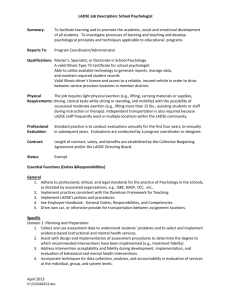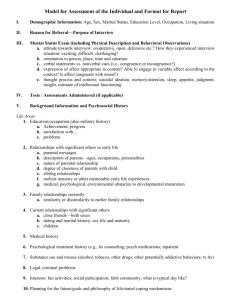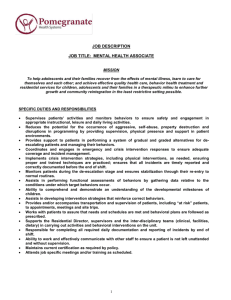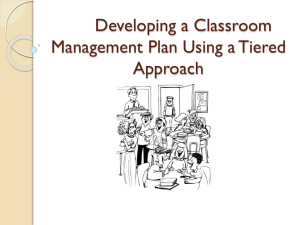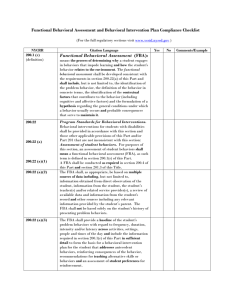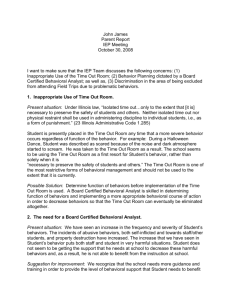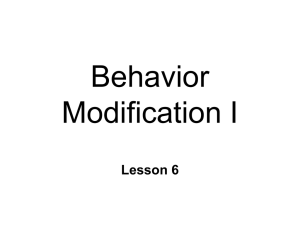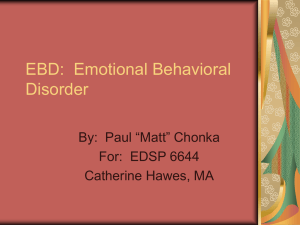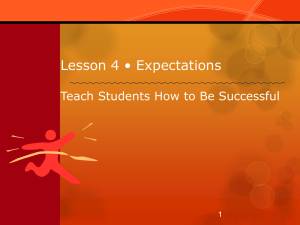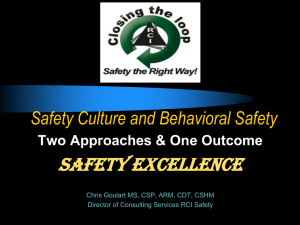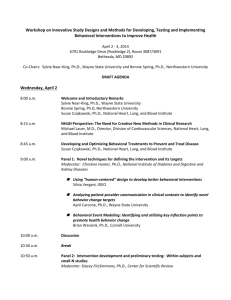Powerpoint - UCLA School of Public Health
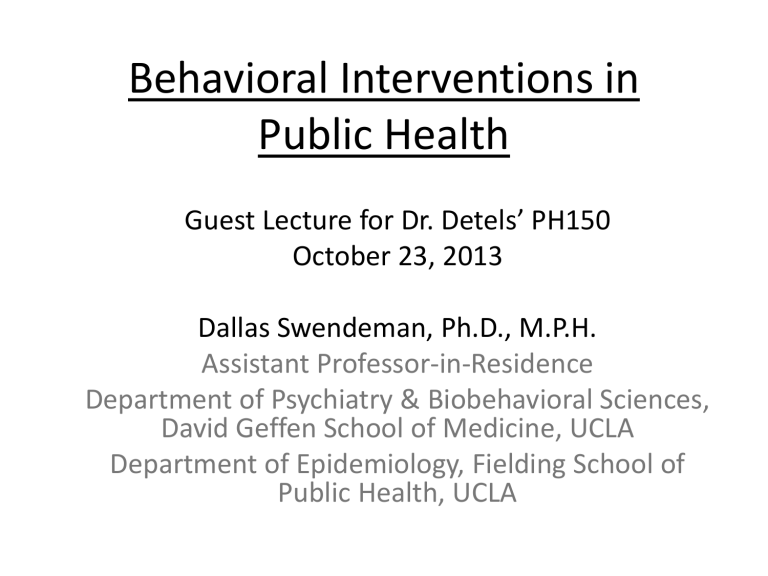
Behavioral Interventions in
Public Health
Guest Lecture for Dr. Detels’ PH150
October 23, 2013
Dallas Swendeman, Ph.D., M.P.H.
Assistant Professor-in-Residence
Department of Psychiatry & Biobehavioral Sciences,
David Geffen School of Medicine, UCLA
Department of Epidemiology, Fielding School of
Public Health, UCLA
Behavioral vs. Biomedical
• Biomedical interventions
– Vaccines, pharmaceutical treatments, & medical devices to prevent & treat disease
• Behavioral interventions
– Programs that help people change their behaviors to prevent & manage disease
• Almost all biomedical interventions require behavior changes – by patients, providers, organizations, etc.
Behavioral vs. Structural
• Behavioral Interventions
– directly target people to change their behaviors
• adoption & utilization of tools or services
• adherence to treatments & lifestyle recommendations
• Structural Interventions
– change in access, availability, or acceptability
• Policies, prices, payers, laws
• Physical & social environments (culture), organizations, communities
Behavioral vs. Structural
• Structural = change in access, avail, accept
– Ex. Condom avail, Testing/Tx avail, N&S
Exchange/Sale, Policies – State & Org
• Behavioral = directly target people to change
– Ex. Condom use, Reduce # Partners, Clean Equip.,
Service Util.
Behaviorally Targeted Structural
Interventions
• E.g., condom or clean syringe access, treatment availability (& use & adherence)
• 100% Condom use program – Top Down
• Community-led structural intervention
– Mobilization of people and resources
CONSORT Intervention Reporting
Domains – Pt. 1
• Content/Elements
– Content & How Delivered (oral, written, video, computer, text-message)
• Providers
– Physicians/Experts/Social Workers vs. Peer/Lay/CHW
• Format
– Self-help, individual, group, telephone
• Setting
– Clinic, CBO/NGO, school, classroom, workplace, homes, venues (brothels, bars, clubs)
CONSORT Intervention Domains Pt. 2
• Recipients
– Target populations
• Intensity
– # of contacts & total contact time
• Duration
– Period of time & spacing of contacts
• Fidelity
– Delivered as Intended & Monitored/Measured (M&E)
* Need a science of intervention design & delivery
Behaviors vs. Knowledge, Attitudes,
Beliefs (KAB)
• Knowledge may be necessary but is often not sufficient for behavior changes
• Rational Actor Assumptions
• Health Education vs. Beh. Change (Psych, Econ)
• Motivation, Information, Skills, Address Barriers,
Support to Sustain change
Evidence-Based Interventions (EBI)
• Systematic programs to support behavior change
– Typically a manual guides training & implementation
– more structured than an “Evidence-based Practice”
• Adopted medical “product development” model
– vaccines, pharmaceuticals, devices
• Rigorous evaluation of risks and benefits
– At least one RCT, some say 2 RCTs
– Some say must be “replicated” by other teams
– Some say large-scale “effectiveness” trial needed
Recipient “Target Population” Risks:
• Diagnosed or Infected
• High-Risk
– Behavioral, genetic, & epidemiological risk factors
• At-Risk
– Potential for high-risk or infection if there is shift in behavior, environment, or epidemiology
• Low-risk
* Address stigma & “victim blaming”
Intensity & Duration:
• Brief vs. Comprehensive
• Sustaining Impact Generalizing Impact
• Duration of behavioral changes
• Breadth of behavioral changes
Delivery Formats:
• Mass Media (inform vs. behavior change)
• Community-level & Networks
• Small Group
• One-on-One
• New Delivery Formats:
– Mobile Phones & Internet
Providers:
• Professionals (Physicians, Therapists)
– vs.
• CHWs – Task Shifting
• Self-directed?
• Stigma
Settings:
• Clinical vs. Community (CBO / NGO)
• Disease-Specific vs. Wellness & General Health
• Age & Gender Segregated vs. Family Focused
Content/Elements:
• Almost completely unspecified
– new work in this area
• Manuals scripted & sequenced
• Theory?
– Explains hypothesized change process & targets
– Rarely specifies the content or techniques
– More in common than different (use multiple)
• Common Elements
• Principles, Processes, Techniques, Practices,
• Common Factors
• Standardized Functions
Behavior Change Theories
• Health Belief Model (Becker)
– Knowledge & beliefs
• Social Learning theory (Bandura)
– Social norms & rewards
• Stages of Change (Prochaska & DiClimente)
– Pre-contemplation, contemplation, ready, action, relapse, maintenance
• Diffusion of Innovations (Rogers)
– Community-level
– Innovators, early-, middle-, late- adopters
Fidelity:
• Fidelity to what?
– Scripted manuals
– Essential practices
– Common factors, processes, principles
• Adaptation?
– Is it still an EBI? New trial needed?
• M&E vs. CQI Feedback Systems
Provider-level Intervention
• Behavior Change like any other
• Adopt new practices
• Implement with fidelity
• Adaptation?
Technology – Mobile Phones
• 5 standardized functions for behavioral intv.
– Inform – about disease risks, protection, services
– Train - new health behaviors and routines
– Monitor – behaviors and risks
– Shape – behaviors over time with feedback
– Support – from peers/family to sustain behaviors
• Also for care coordination, CHW support, M&E
“Feature” Phone Applications
mHealth CHW System
(from Mobenzi.com
; also Dimagi.com)
Fidelity Monitoring & Support for
Intervention Deliverers (& Dose/Exp.)
If we build it, will they come?
• Hard to reach populations (stigma)
• Engagement Strategies
• Costs & Cost-effectiveness
• Payers & Sustainability
